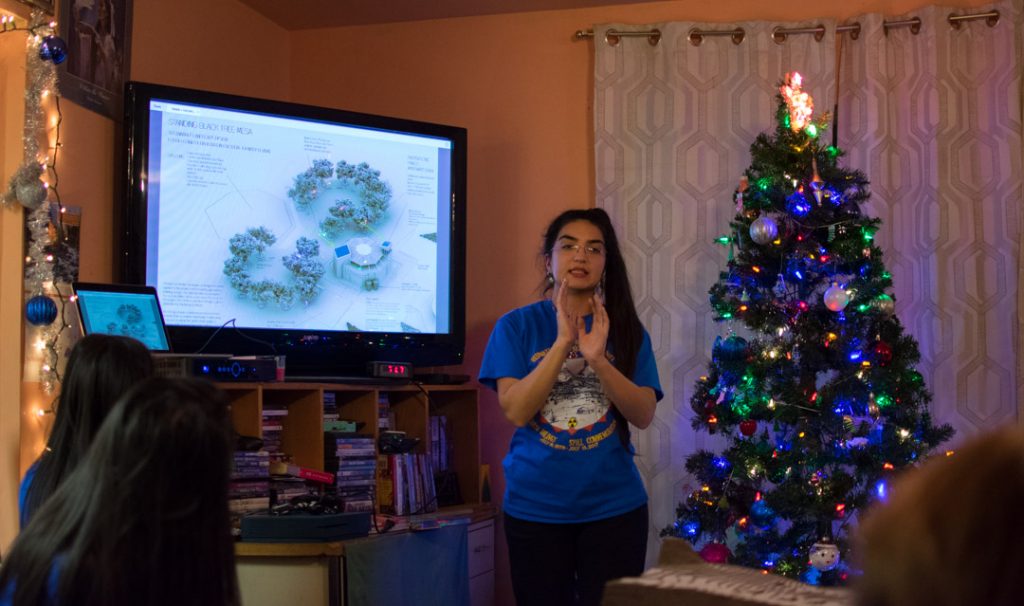The Red Water Pond Road Community, near Gallup, New Mexico, has been ravaged by toxic uranium mining damaging their homes and sacred sites related to the federal government’s nuclear arms build-up during the Cold War.
Now, hoping to provide some liveable solutions, the University of New Mexico’s School of Architecture has designed a sustainable, “off-grid settlement” upwind of the contamination site, hoping to allow the indigenous residents to live nearby on their same ancestral lands.
The resettlement design plan is being led by Catherine Page Harris, a professor in the Architecture and Planning and Fine Arts departments at UNM. She is acting as a staff advisor for two graduate students working on the project.
She said she is inspired by how landscape and architecture can intersect by sharing utilities.
“I am also interested in Indigenous design both as a way to intersect with this particular place and its history and culture,” Harris said.
Harris said the planning started after the Red Water Pond Road Community (RWPRC) contacted the Indigenous Design and Planning Institute (IDPI) — a program in the Department of Architecture and Planning — to find a way to receive support and grants to aid in the resettlement.
Sunanda Sharmin, a UNM architecture graduate student, first took note of the project in the Fall of 2017.

“Our work focused on how much water they get in a year and creating a footprint of the houses and creating a master plan… so working with what their requirements are,” Sharmin said.
The project picked up steam in 2018 once Harris started to apply for funding. It received $20,000 from the Indian Land Tenure Foundation and the Office of the Vice President for Research at UNM.
The funding lasted for three months in 2018, which enabled two students to work on the project.
According to Harris, the challenges of building in the area is the lack of infrastructure. This led to an innovative design.
“We also worked with their interests to have eastern facing doorways… we had a large set of discussions about the Hogan and how it needed to be a separate space that can be used as living space,” Harris said.
The next step in the design logistics, according to Harris, is to install a rainwater collection gauge in April. This is because the degree of groundwater contamination is unknown — and most likely unhealthy.
“If you’re living off the grid, one of the biggest limiting factors is water,” Harris said. “We just can’t be sure if the groundwater is contaminated.”
One of the other concerns for the Red Water Pond Road Community is maintaining the cultural integrity of their infrastructure. According to a report filed by the New Mexico Environmental Law Center, the homes and the communal building must be culturally appropriate if the resettlement plan is to succeed.
Through discussion with the community, a number of Navajo architectural traditions were preserved in the design, according to Harris, such as how doors should face East.
How current neighborhoods are designed from a visual perspective is important to the people in the community. This includes structures for religious ceremonies and the homes based on Navajo design, known as the Hogan.
“If you look at existing Navajo clustering, there’s basically a spatial dispersion,” Harris said.
There was also the concept of a community center, Sharmin said.
Teracita Keyanna, a spokesman for the community, told KUNM Radio that working with Harris and her students has been a much easier process than working with the Environmental Protection Agency (EPA).
Keyanna also made note of how the effects of uranium waste is a generational problem, saying that the kids and elderly of the community should have their voices heard in the fight for a sustainable future, free of uranium waste.
“We don’t want to leave our children out of this whole conversation,” Keyanna said, according to KUNM Radio. “I constantly teach our children that they have a voice even though politicians don’t listen to them. We try to make sure that everybody at the table is at an understanding point so that we don’t leave anyone behind.”
Indigenous communities have been disproportionately impacted by the extraction of radioactive resources in New Mexico, a historic result of the United States’ participation in the nuclear arms race.
Harris and others involved in the project have received special donorship from the IDPI towards the creation of a memorial in honor of the impact that resource extraction had upon indigenous peoples. The memorial would overlook the sacred site, nearby Shiprock and operate as a peace center.
This initiative has been opposed by the EPA, whose proposition is to relocate the community to mobile homes or hotels during the restoration process which could take years.
Harris said she has been personally approached by an EPA representative at a meeting at the community who said that it was his job to ensure the community was moved to an EPA-approved location.
“I told him, well it’s my job to move them to an appropriate settlement,” Harris said.
Harris also said that the funding the EPA proposed would be nearly enough to complete the construction of the settlement and that the goal should be to keep the money in the community creating an opportunity for jobs and collaboration, rather than outsourcing the work.
Though the project led by Harris and her students has gotten off the ground, money, in the end, is the defining factor in seeing the sustainable community being built, Harris said.
Matthew Narvaiz is a reporter for NM News Port, he can be contacted on Twitter @matt_narvaiz.
Shelby Coen is a reporter for NM News Port, they can be contacted on Twitter @desert_youth.